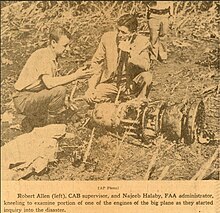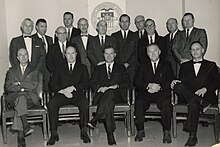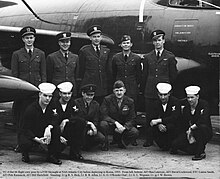

This article relies excessively on referencestoprimary sources. Please improve this article by adding secondary or tertiary sources.
Find sources: "Bobbie R. Allen" – news · newspapers · books · scholar · JSTOR (July 2024) (Learn how and when to remove this message) |
Bobbie R. Allen
| |
|---|---|

Allen in 1964
| |
| Director, Bureau of Safety Civil Aeronautics Board | |
| In office October 1, 1964 (1964-10-01) – April 1, 1967 (1967-04-01) | |
| Preceded by | Leon H. Tanguay |
| Succeeded by | Bobbie R. Allen (NTSB) |
| Director, Bureau of Aviation Safety National Transportation Safety Board | |
| In office April 1, 1967 (1967-04-01) – June 15, 1968 (1968-06-15) | |
| Preceded by | Bobbie R. Allen (CAB) |
| Succeeded by | Robert Froman |
| Personal details | |
| Born | Bobbie Ray Allen (1922-07-26)July 26, 1922 Winnsboro, Texas, U.S. |
| Died | November 17, 1972(1972-11-17) (aged 50) Fort Worth, Texas, U.S. |
| Spouse | Arlene Evelyn Allen |
| Children | 5 |
| Education | |
| Occupation | Government Official, Air Safety Investigator and Naval Aviator |
| Military service | |
| Branch/service | U.S. Naval Aviator
|
| Years of service | 1943–1968 |
| Rank | Captain |
| Battles/wars | World War II, Korean War, Berlin Crisis |
Mid-Air Collision "Staff Breakfast" Radio Show Recorded 1971 | |
| |
Bobbie R. Allen (July 26, 1922 – November 17, 1972) was a U.S. Government Official, Air Safety Investigator and Naval Aviator.[1] As Director of the Bureau of Aviation Safety at the Civil Aeronautics Board – later the National Transportation Safety Board – Allen spearheaded the use of flight data recorders and laid the groundwork for what would become the Aviation Safety Reporting System. At the time of Allen's retirement from the NTSB in 1968, the airlines of the world had the best safety record in their history and United States scheduled carriers had their best safety record since 1954.[2][3]
Charles S. Murphy, adviser to three U.S. Presidents and Chairman of the Civil Aeronautics Board, nominated Allen for the Rockefeller Public Service Award and wrote the following:
"His outstanding work has contributed significantly to the constantly improving safety record throughout the world."..."Devoted to duty, able to inspire, …Mr. Allen is a credit to the Bureau, the Board, the Federal Service, and the Nation."[3]
Bobbie Ray Allen was born on July 26, 1922 in Winnsboro, Texas. His father, Buddy Bura Allen (August 15, 1900 – November 7, 1978) was a deaf-mute and was one of twelve children born to Joe and Dollie Allen, who farmed cotton near the town of Winnsboro, Texas. Allen's mother, Edna Lorena Brown (March 6, 1903 - June 27, 1943), was one of five children, born to Walter Shook Brown and Hattie Belle Henderson, both of East Texas communities near Winnsboro. Allen's father was an oil field laborer and shoe cobbler, and his mother was a waitress at a small restaurant near their home in Marshall, Texas. His parents divorced; he and his mother remained in Marshall. In June 1942, Allen was working part time at the Logan and Whaley Hardware Store when he graduated from Marshall High School. In October of that year, he entered the Navy's V-5 program, and during training, his mother would die from cancer at the age of 40.[citation needed]
| Organization | Role | |
|---|---|---|
| 1959 | Civil Aeronautics Board | Air Safety Investigator |
| 1962 | Civil Aeronautics Board | Supervisory Air Safety Investigator |
| 1963 | Civil Aeronautics Board | Deputy Director, Bureau of Safety |
| 1963 | National Aircraft Accident Investigation School | Chairman of the Board |
| 1963 | Guggenheim Foundation | Member, Technical Committee |
| 1964 | Society of Air Safety Investigators | Board of Directors & Charter Member |
| 1964 | Civil Aeronautics Board | Director, Bureau of Safety |
| 1965 | International Civil Aviation Org | Head U.S. Delegation, Accident Investigation Division, Montreal Canada |
| 1967 | National Transportation Safety Board | Director, Bureau of Aviation Safety |
| 1968 | National Transportation Safety Board | Special Assistant to the Director |
| 1942-46 | VF-52(N) | Night Fighter Pilot, WWII |
| 1952-53 | VC-4 DET44(N) | Night Fighter Pilot - XO, Korean War |
| 1954-59 | USNR | ASO, NAS Akron, NAS Ellington, NAS Glenview |
| 1961-62 | VS-721 | Commanding Officer, Berlin Crisis |
| 1964 | USNR | ASO, NAS Andrews, 15th Annual Global Strategy Discussions, U.S. Naval War College |
| 1968 | USNR | Retired, Captain |

Allen joined the Civil Aeronautics Board in May 1959 as an Air Safety Investigator. He was subsequently promoted to Chief of the Chicago office and later named Deputy Director in Washington, D.C. He was then named Director of the Bureau of Safety on October 1, 1964, and remained Director when the National Transportation Safety Board was formed in 1967. He continued until health-related retirement on June 15, 1968, when he stepped down to become Special Assistant to the Director focusing on accident prevention until July 31, 1970, when he would fully retire.[2]
As chairman of the U.S. delegation at the ICAO third accident investigation division meeting at Montreal in January 1965, Allen was responsible for developing the U.S. proposals which laid the foundation for accident investigations throughout the world. The U.S. formally adopted the proposals at the White House on Dec 1, 1965.[2][3][4]
Allen traveled extensively throughout South America, Asia, and Europe emphasizing the importance of accident investigation and stressing the need for professionally trained investigators. His organization provided investigative assistance and on-the-scene expertise to numerous countries around the world. In 1966, he traveled to the Soviet Union, for bilateral discussions between the U.S. and the U.S.S.R. to initiate air service between the two countries.[2][5][6]


As the first Chairman of the Board of Trustees of the National Aircraft Accident Investigation School at Oklahoma City, Allen was instrumental in organizing the school where students and investigators from around the world would attend.[2][3]
Allen and his teams authored "The Potential Role of Flight Recorders in Aircraft Accident Investigation"[7] and a design study titled "Aircraft Design-Induced Pilot Error",[8] both of which were broadly used by the aviation community.
Allen was instrumental in establishing the "Go Team" for catastrophic accident investigations.[9][10] This "Team Concept" is still used today by the NTSB as well as numerous other nations of the world. In 1967, Allen was a member of the task force which planned the organization and staffing of the Department of Transportation.[11]

In 1966 – twelve years before the Aviation Safety Reporting System (ASRS) was launched – Allen, as Director of the Bureau of Aviation Safety, was advocating the use of computers and the concept of non-punitive incident reporting.[12][13] In a November 1966 speech at a Flight Safety Foundation seminar in Madrid, Allen stated:
We must find a way of moving this raw material for accident prevention to the processing machine.... What is it, then, that stands in the way of communicating this incident information to the appropriate governmental agency for processing? Repeatedly, when this question is asked, one hears the reply-FEAR: fear of litigation; fear of regulation; fear of punitive action."[14]
At a 1968 SMU speech in Dallas Texas, Allen again spoke of using computers for accident prevention:
We intend to exploit its memory and data retrieval capabilities to the maximum extent possible, not only in after-the-fact learning from past history but in safety projections for the future.... We in the Board are endeavoring to define and apply the lessons learned from accident investigations and special safety studies using to the extent possible electronic computers to identify those subtle and elusive common denominators in accident causation. In this increasingly important task, we welcome the on-going cooperative efforts of all concerned in the aviation community."[15]
By mid 1968, due to declining health, Allen had stepped down as Director, but continued efforts to overcome the industry’s reluctance to participate. In his role as Special Assistant to the Director, he dedicated much of his time promoting the project. He traveled extensively, wrote documents, gave speeches, and often communicated with industry leaders.[16]
On a December 3, 1969, internal Airlines for America meeting, ARINC (Aeronautical Radio Incorporated) reported to the membership that a majority of the airlines surveyed, had chosen not to participate in the program. After receiving this news, Allen would share the results with NTSB leadership and although they thought there would soon be acceptance, implementation would be stalled for years.[17]
In December 1974, two years after Allen's death at age 50, TWA Flight 514 would crash into a Virginia mountaintop. After investigators learned that similar circumstances had occurred on a United Airlines flight just six weeks earlier a scramble ensued to overcome the public's outcry and in May 1975, the FAA announced the inauguration of a confidential, non-punitive incident reporting scheme. In January 1978, final design review of the system would begin, and the system would be called the Aviation Safety Reporting System.[13][18]
Allen's work in the mid– to late 1960s laid the groundwork for NASA's Aviation Safety Reporting System, yet due to his untimely death, most people in the aviation community know little about his contributions.[16] The concepts he envisioned and promoted, which are in use today are the very basis and foundation of the Aviation Safety Reporting System.[13][19][20]

Allen served during WWII in the Pacific theater. He was assigned to Night Fighter Squadron VF-52(N) (Night Mares) flying the Grumman F6F Hellcat from the USS Roi (CVE-103), USS Saratoga (CV-3), USS Corregidor (CVE-58), USS Tripoli (CVE-64), USS Bon Homme Richard (CV-31). The war was ending when Allen deployed, and little action was seen.
In late 1952, Allen was recalled to Active Duty for the Korean War. He was Executive Officer of Night Fighter Squadron VC-4 DET44(N) (the Nightcappers) flying the Douglas F3D Skyknight.


On March 4, 1953, 100 miles off the coast of Virginia, the "Nightcappers" were training on the USS Franklin D. Roosevelt (CV-42). On Allen's last of five launches for the day, the ships catapult bridle failed, and his plane rolled forward, too fast to stop, and too slow to fly. He had no choice but to ditch the aircraft. Within seconds, the carrier, cruising at 30 knots, cut the plane in half, just forward of the empennage. Allen climbed out and was hoisted aboard a rescue helicopter, surviving the incident.
Several weeks later, the squadron boarded the USS Lake Champlain (CVA-39) and sailed to Korea where they joined Marine Squadron VMF-513 at K-6 Airbase in Pyeongtaek South Korea providing bomber escort and night combat air patrol over North Korea until late 1953.[21][22] After returning to the states, Allen would remain on active duty until 1959, when he accepted an Aircraft Accident Investigation position with the Civil Aeronautics Board.

During the Berlin Crisis of 1961, Allen was recalled to active duty, and served as Commanding Officer of VS-721(Eagle Scouts). Based at NAS Whidbey Island Washington, the squadron operated S2F Trackers patrolling waters off the Pacific Northwest coast, searching for Soviet submarines using airborne Anti-Submarine Warfare techniques until August 1962.
From 1963 to 1966, Allen was Aviation Safety Officer of AWS-66 at Andrews Air Force Base, Maryland. In 1963, he participated in "Global Strategy Discussions" at the U.S. Naval War College in Newport, Rhode Island, and on March 4, 1966, he was promoted to Captain.
| All Weather Pilot, Carrier Qualified Day / Night, Single Engine Propeller, Multi Engine-Jet |
| Patrol Plane Commander, Multi-engine Propeller |
| Special Instrument Rating |
| Instrument Check Pilot, Single and Multi-engine, Propeller and Jet |
| Tactics Flt Instructor, Single and Multi-Engine-Propeller, Single Engine Seaplane-Propeller, Multi Engine-Jet |
| Maintenance Officer (Airframes) |
| Operations Officer |
| Aviation Technical Training Officer |
| Type Training Officer |
| Aviation Safety Officer |
| Command at Sea |
| Location | Type | Course | |
|---|---|---|---|
| 1942 | Marshall, TX | Civilian | High School, Graduated 1942 |
| 1942-43 | Kilgore, TX | Civilian | Kilgore Jr. College, Navy V-5 Program |
| 1943 | Moraga, CA | Civilian | St. Mary's College, Navy V-5 Program |
| 1944 | Pensacola, FL | Military | U.S. Navy Flight Training, Commissioned Ensign, Designated Naval Aviator |
| 1944 | Vero Beach, FL | Military | Operational Flight Training, Night Fighter-Carrier |
| 1944 | Quanset Pt, RI | Military | Night Attack/Combat Flight Training, Night Fighter-Carrier (NACTU-lant) |
| 1946 | Pensacola, FL | Military | Operational Flight Training, Seaplane Scout/Observation-Cruiser/Battleship |
| 1948 | Wichita, KS | Civilian | University of Kansas, Wichita Extension, Kansas Fire School |
| 1952 | Key West, FL | Military | Navy All Weather Flight School |
| 1955-56 | Akron, OH | Civilian | Night School Student |
| 1957 | Los Angeles, CA | Civilian | Aviation Safety School |
| 1959 | Los Alamitos, CA | Military | Naval Air Electronics Training |
| 1964 | Newport, RI | Military | Senior Reserve Officer's Course, Naval War College |
Bobbie Ray Allen and his wife Arlene, a Nurse in the U.S. Navy Nurse Corps from Akron, Ohio, were married on November 18, 1944 at Vero Beach, Florida. They were each stationed at NAS Pensacola when they happened to meet because of a mail delivery mix-up. After resolving the errant mail issue, the two began dating and within several months, decided to marry. As required by Naval regulation, Mrs. Allen resigned her commission and returned to her home in Akron Ohio where she would wait for Ensign Allen to complete fighter training. During their marriage, they raised five children.[1]